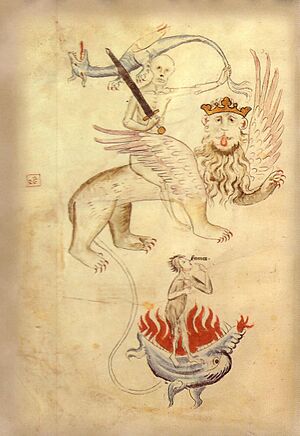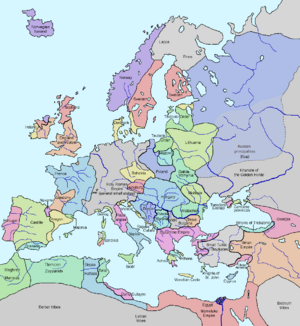Great Famine of 1315–1317 facts for kids
The Great Famine of 1315–1317 was a terrible time when many people in Europe faced extreme hunger. It was the first of several big problems that hit Europe in the early 1300s. This famine affected most of Europe, from Poland in the east to the Alps in the south. It caused many deaths over several years. This period marked the end of a time of growth and wealth that Europe had enjoyed from the 11th to the 13th centuries.
The Great Famine began with very bad weather in the spring of 1315. Crops failed for two years, through 1316 until the summer harvest in 1317. Europe did not fully recover until 1322. It wasn't just crop failures; a disease among cattle also caused sheep and cattle numbers to drop by as much as 80 percent. This crisis had a huge impact on the Church, governments, and society in Europe. It also set the stage for other disasters later in the 14th century.
Contents
What Caused the Famine?
Famines were common in medieval Europe. For example, local famines happened often in France and England. For most people, there was often not enough food. Life was a short and difficult struggle to survive.
During the Medieval Warm Period (from the 10th to the 13th centuries), Europe's population grew a lot. In some places, the population was so high that it wasn't reached again until the 1800s. The amount of wheat harvested per seed planted had been falling since 1280. Food prices were also going up. If harvests were good, you might get 7 seeds back for every one planted. But if harvests were bad, you might only get 2 seeds back. One seed was needed for next year's planting, leaving only one for food. Today, farmers can get 30 seeds or more back for each one planted.
The Great Famine started after the Medieval Warm Period ended. Between 1310 and 1330, Northern Europe had some of the worst and longest periods of bad weather in the Middle Ages. Winters were very cold, and summers were rainy and cool. Some historians think a volcanic eruption might have caused the famine. It happened during a period called the Little Ice Age. Changing weather, governments that couldn't handle crises well, and a very large population meant there was little room for error in food production.
The Great Famine Strikes
In the spring of 1315, unusually heavy rain began across much of Europe. It kept raining through the spring and summer, and the temperature stayed cool. Because of this, grain could not ripen, leading to widespread crop failures. Farmers tried to keep grains dry indoors. Hay for animals could not dry, so there was no food for livestock. The ground became too wet to plow fields for new planting.
Food prices quickly began to rise. In England, prices doubled between spring and midsummer. Salt, which was needed to preserve meat, became hard to get. This was because the wet weather made it difficult to dry out salt from seawater. Its price went up a lot. In Lorraine, wheat prices rose by 320%, making bread too expensive for most people. Only kings, nobles, rich merchants, and the Church had stores of grain for emergencies. Because there were so many people, even slightly bad harvests meant some people would go hungry. People started looking for wild roots, grasses, nuts, and bark in the forests to eat.
There are many stories that show how bad the famine was. King Edward II of England visited St Albans in August 1315. He had trouble finding bread for himself and his group. This was very unusual for a king. In Bristol, city records said that in 1315 there was "a great Famine... with such mortality that the living could scarce suffice to bury the dead." People were so desperate that they ate horse meat and dog meat. Some even did terrible things because of extreme hunger.
The French army, led by Louis X, tried to invade Flanders. But in the low-lying areas of the Netherlands, the fields were so wet that the army got stuck. They had to retreat, burning their supplies because they couldn't carry them away.
In spring 1316, it continued to rain. People across Europe were weak and had no food left. Everyone was affected, from nobles to peasants. Peasants made up 95% of the population and had no extra food. To survive, people had to kill their farm animals and eat the seeds they needed for future crops.
The famine was at its worst in 1317, as the wet weather continued. That summer, the weather finally returned to normal. But by then, people were so weak from diseases like pneumonia, bronchitis, and tuberculosis, and so much seed had been eaten, that it took until 1325 for food supplies to return to normal levels. The population then slowly began to grow again. Historians believe that 10–25% of the people in many cities and towns died. The Black Death (1347–1351) would kill even more people, but it usually swept through an area quickly. The Great Famine lasted for years, causing long-term suffering.
The Great Famine caused many deaths in a world that was already very crowded, especially in towns. In southern England, about 10–15% of the population died. Northern France lost about 10% of its people.
Where the Famine Happened
The Great Famine mainly affected Northern Europe. This included Ireland, Britain, Northern France, the Low Countries, Scandinavia, Germany, and western Poland. It also affected some of the Baltic states. The famine did not reach south of the Alps and the Pyrenees mountains.
Impact of the Famine
The Great Famine is important because of how many people died, how large an area it affected, how long it lasted, and its lasting effects.
Impact on the Church
When God saw that the world was so over proud,
He sent a dearth on earth, and made it full hard.
A bushel of wheat was at four shillings or more,
Of which men might have had a quarter before ...
And then they turned pale who had laughed so loud,
And they became all docile who before were so proud.
A man's heart might bleed for to hear the cry
Of poor men who called out, "Alas! For hunger I die ...!"
In medieval times, people often believed that natural disasters were God's punishment for their wrongdoings. In a society where religion was the answer to almost all problems, no amount of prayer seemed to stop the famine. This made some people lose faith in the Catholic Church. It helped set the stage for later movements that the Church called heretical. These groups blamed the Church's leaders for the problems.
Changes in Society
The famine led to a big increase in crime. Even people who were normally law-abiding would do anything to feed themselves or their families. For many years after the famine, Europe became a tougher and more violent place. It was less friendly than it had been in the 12th and 13th centuries. This change was seen everywhere, even in how wars were fought. During the Hundred Years' War in the 14th century, the idea of chivalry (knightly honor) began to fade. In earlier centuries, nobles were more likely to die in tournament games than in battle.
The famine also made people lose trust in medieval governments. They felt that their leaders failed to deal with the crisis. This was especially bad for King Edward II of England, who was already unpopular. While people saw the famine as a punishment from God, the English were more likely to blame their king's poor rule and behavior. This contributed to his removal from power in 1327.
Population Decline
The Great Famine brought an end to a long period of population growth that had started around 1050. Although some believe growth was already slowing down, the famine definitely stopped it. The effects of the Great Famine also made future events worse, like the Black Death. When the Black Death arrived, the population was already weakened by years of hunger and disease, making them even more vulnerable.
See also
 In Spanish: Gran hambruna de 1315-1317 para niños
In Spanish: Gran hambruna de 1315-1317 para niños
- Popular revolts in late-medieval Europe
- List of famines



